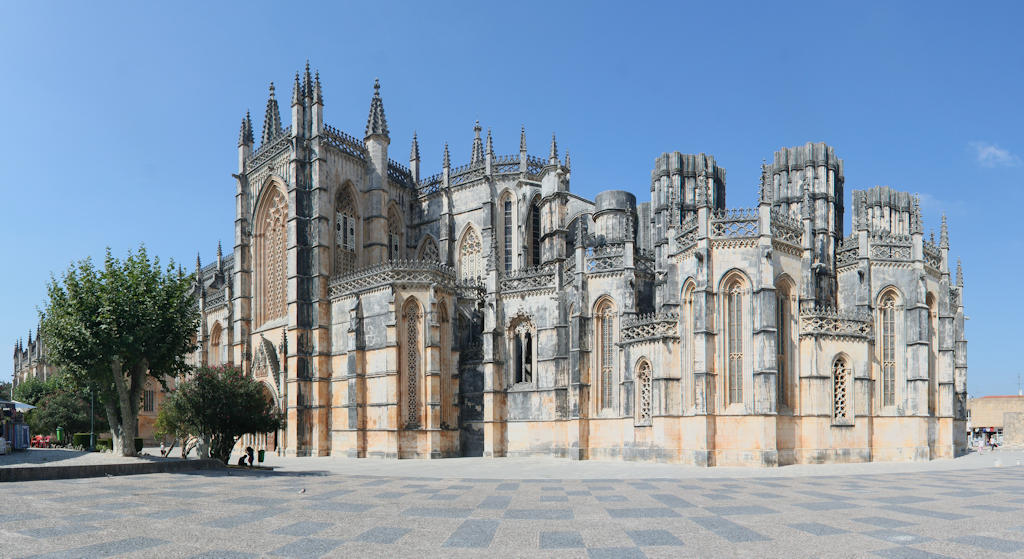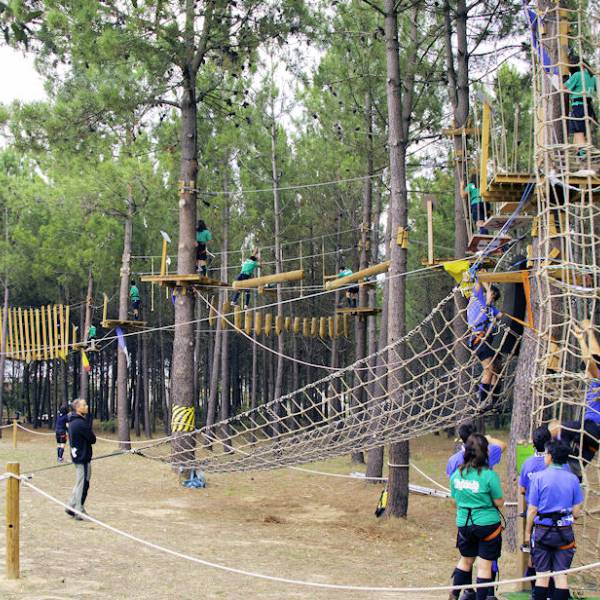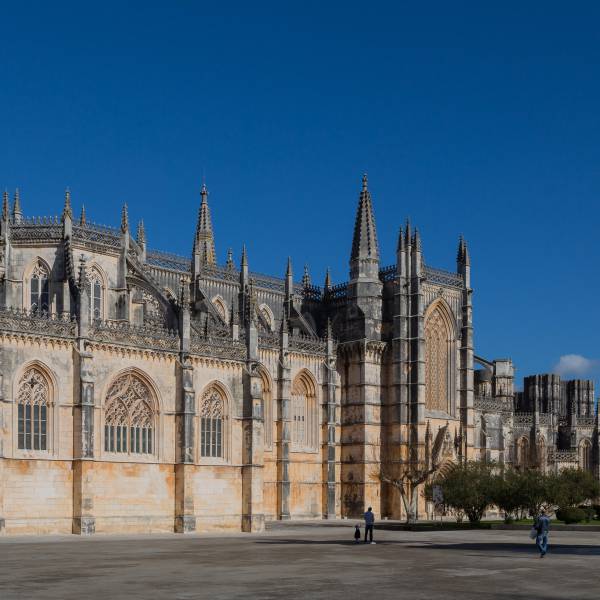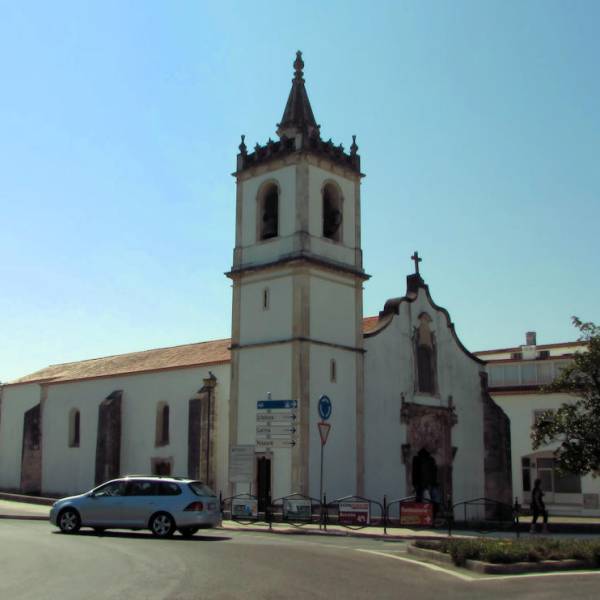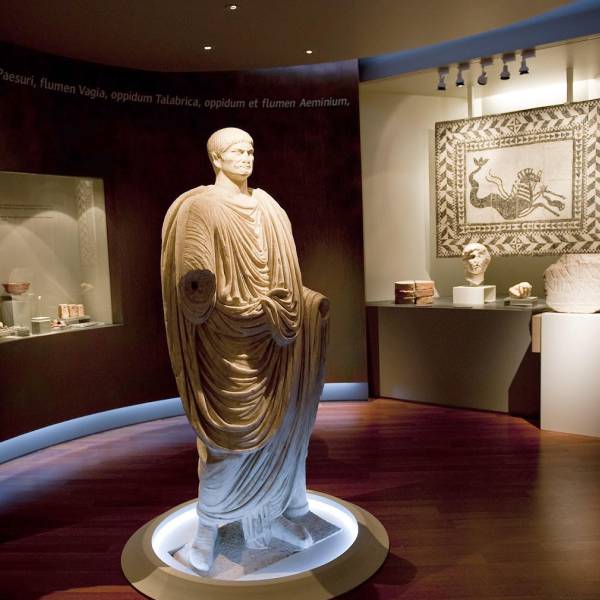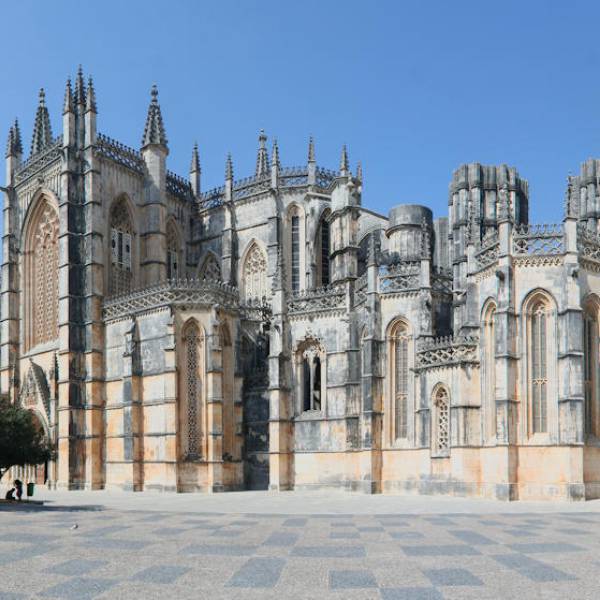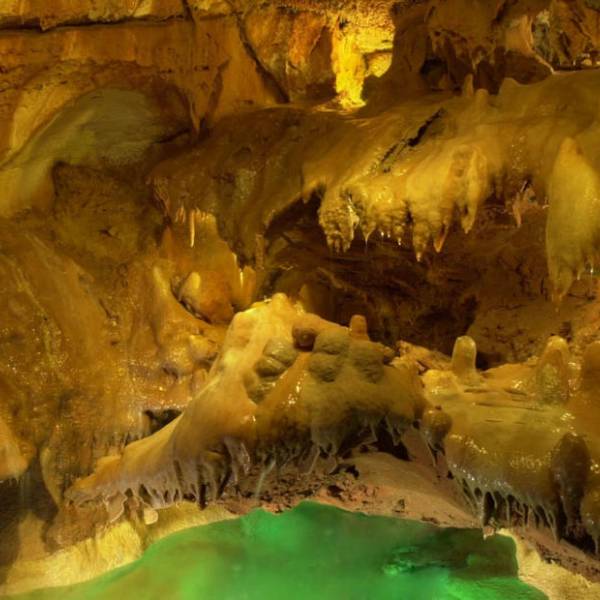Batalha Monastery is a highly recommended day trip from Lisbon, offering a captivating journey into Portugal's past. Located approximately 120 kilometers north of Lisbon, the scenic route allows travelers to appreciate the picturesque Portuguese countryside. Visiting this UNESCO World Heritage Site provides a unique opportunity to witness Gothic architecture at its finest, while also delving into the country's vibrant history. Batalha Monastery's profound cultural and historical significance makes it a must-visit destination for architecture enthusiasts, history buffs, and those seeking a deeper connection with Portugal's heritage.
History and Construction:
Batalha Monastery, also known as the Monastery of Santa Maria da Vitória, is an awe-inspiring testament to Portugal's rich heritage and historical significance. Built as a gesture of gratitude to the Virgin Mary for the Portuguese victory over the Castilians in the Battle of Aljubarrota in 1385, the monastery stands as a masterpiece of Gothic architecture and a symbol of national pride.Construction of the monastery began in 1386 and lasted for over a century, until approximately 1517. The efforts of fifteen architects, including notable figures such as Afonso Domingues, Huguet, Fernão de Évora, and Mateus Fernandes, contributed to the monastery's remarkable design and construction. These architects brought new techniques and artistic styles, previously unseen in Portugal, resulting in a unique blend of Rayonnant Gothic, Flamboyant Gothic, and Manueline influences.
The monastery's architectural features are truly remarkable. The main façade displays intricate detailing and flamboyant Gothic elements, while the dome of the square chapter house and the Founder's Chapel exhibit exquisite craftsmanship. The Cloister of Afonso V, added by architect Fernão de Évora, showcases the transition from Gothic to Manueline style. The Capelas Imperfeitas, or Unfinished Chapels, designed by Mateus Fernandes and Diogo Boitac, feature captivating tracery and arcades.
Throughout history, Batalha Monastery has endured significant challenges. It suffered damage during the 1755 earthquake, and devastating destruction occurred when the complex was sacked and burned by Napoleonic troops in 1810 and 1811. The expulsion of the Dominicans in 1834 led to the abandonment and gradual ruin of the church and convent.
Fortunately, in 1840, King Ferdinand II of Portugal initiated a restoration program to save the neglected and crumbling monastery. The restoration efforts, which lasted well into the 20th century, aimed to revive this Gothic architectural gem. Noteworthy among the restoration team was master stonemason Jose Patrocinio de Sousa, who played a crucial role in rebuilding the monastery. In 1907, Batalha Monastery was rightfully declared a National Monument, acknowledging its historical and cultural significance.
Architectural Marvel:
The Architecture of Batalha Monastery is a testament to the skill and craftsmanship of its builders. The convent stands proudly apart from the town, with its magnificent western façade facing a large square adorned with the equestrian statue of General Nuno Álvares Pereira. The façade is divided into three sections, marked by buttresses and pilasters: the Founder's Chapel, the side wall of an aisle, and the projecting portal. Adjacent to the church choir is the Chapterhouse, while the Cloister of King João I and the Cloister of King Afonso V border the church. Additionally, the complex is home to the Unfinished Chapels, a separate octagonal structure, and the Tomb of the Unknown Soldier from the First World War.The portal of Batalha Monastery is a sight to behold, adorned with a profusion of 78 statues. These statues, divided over six rows, depict Old Testament kings, angels, prophets, and saints, each under a baldachin. The splayed sides of the portal display statues of the apostles, with one standing on a chained devil. The tympanum portrays Christ enthroned, sitting under a baldachin and flanked by the four Evangelists, each with their own attribute.
The interior of Batalha Monastery is characterized by its vastness and narrowness in proportion to its height. The nave, raised by the second architect Huguet, creates a unique and imposing atmosphere. The lack of excessive ornamentation and statues in the nave gives it a sober and minimalist appearance. Ribbed vaults, supported by compound piers, are adorned with ornamental keystones. The church is illuminated by ten stained-glass windows in the clerestory, as well as the tall, traceried windows in the side walls and transept. The choir, extending into two-bay transepts, is composed of five apsidal chapels, with the central one projecting.
Batalha Monastery played a significant role in the development of stained-glass art in Portugal. The workshop for stained-glass windows, likely the first of its kind in the country, attracted German artists from Franconia and Nuremberg. The oldest windows date back to the late 1430s, while the Manueline-style ogival stained-glass windows in the choir were created by Portuguese masters in the 1520s and 1530s. These windows depict scenes from the lives of Jesus and Mary, including the Visitation, Epiphany, Flight into Egypt, and Resurrection of Christ.
The tomb of architect Mateus Fernandes and his wife can be found near the portal, serving as a testament to their contribution to the monastery. Additionally, the tomb of knight Martim Gonçalves de Maçada, who heroically saved the king's life during the battle at Aljubarrota, is located close to the Founder's Chapel.
National Pantheon
In 2016, the Monastery of Santa Maria da Vitória in Batalha was granted the status of National Pantheon, while still maintaining its religious practices. It joined the Jerónimos Monastery in Lisbon as a national pantheon, following the precedent set in 2003 when the Monastery of Santa Cruz in Coimbra became part of the original National Pantheon established in 1966 at the Church of Santa Engrácia in Lisbon.Church
The grandeur of the church (80 meters in length, 22 in width, and 32.5 in height) is a testament to the immense importance that King John I wanted to bestow upon the entire monastery complex. This central area of the monument takes the form of a Latin cross, with the long arm divided into three naves consisting of eight sections each. The transept is substantial and commands attention, almost reaching the height of the nave. The apse is composed of five polygonal chapels, with the central chapel, known as the chancel, being the highest and deepest.Chancel
The chancel appears to have been finished at a later stage, with its beautifully carved triumphal arch. It is also possible to consider two distinct phases of work for the side chapels. In the area of the cloister dependencies, progress may have been faster compared to the main body of the church. The north and west galleries were likely already constructed, but it was Huguet who completed the ones on the south and east sides (all of them consisting of seven sections), while respecting the previous layout. The vaults feature intricate cross-ribbed vaulting with large keystones connected by longitudinal chains, without corbels, resting on slender columns on either side of the walls.Lisbon.vip Recommends
Chapterhouse
The Chapterhouse, also known as the Sala do Capítulo, serves as a reminder of the military origins of the monastery's establishment. As visitors enter, they are greeted by a military honor guard consisting of two sentinels standing watch over the tombs of two unknown soldiers who lost their lives in World War I.This square room is particularly remarkable for its unique star-shaped vault, which spans a square area measuring 19 meters on each side. The design was so audacious for its time that prisoners on death row were enlisted to undertake the construction. After two unsuccessful attempts, the vault was finally completed. Legend has it that, upon the removal of the last scaffolds, Master Huguet spent the night beneath the vault to silence his critics.
One of the notable features of the Chapterhouse is the Renaissance stained-glass window on the eastern wall, dating back to 1508. This exquisite artwork, attributed to the Portuguese painters Master João and Francisco Henriques, portrays scenes from the Passion of Christ.
The Chapterhouse served as a funerary chapel, receiving the tomb of King Afonso V and his wife Isabel of Coimbra from 1481, and ten years later, the tomb of their grandson, Prince Dom Afonso of Portugal, the only descendant of King John II. In 1901, the remains were transferred to the Founder's Chapel.
Founder's Chapel
One of the most important buildings adjacent to the monastery, which indelibly marks its "royal" character and sheds light on the intentions involved, is the Founder's Chapel. It features three conceptual bays and a central octagon, supported by eight piers adorned with crockets and sustaining highly elongated arches.Beneath the star vault of the octagon, there lies the shared tomb of King John I of Portugal (who passed away in 1433) and his wife Philippa of Lancaster (who died in 1415). The statues of the royal couple are depicted in full regalia, with clasped hands symbolizing the strong ties between Portugal and England, and their heads resting on a pillow. Elaborately decorated baldachins adorn the statues, showcasing the coats of arms of the Aviz and Lancaster dynasties, along with the insignia of the Order of the Garter.
Surrounding the octagon, there is an ambulatory adorned with intricate vaulting. Along the southern wall, there is a row of recessed arches containing the tombs of King John I's four younger sons and their respective spouses. From left to right, these tombs are:
- Ferdinand the Holy Prince: He died as a captive in Fez in 1443 but was later recovered, and his remains were relocated to this chapel in 1473.
- John of Reguengos, the Constable of Portugal: He passed away in 1442. His tomb is accompanied by that of his wife, Isabella of Barcelos, who died in 1466.
- Prince Henry the Navigator: His tomb, adorned with a baldachin, commemorates his death in 1460. He remained unmarried.
- Peter of Coimbra: Acting as regent for Afonso V from 1438 to 1448, Peter was killed at the Battle of Alfarrobeira in 1449. His remains were transferred to this chapel in 1456, and his tomb is shared with his wife, Isabella of Urgell, who died in 1459.
On the west wall, there are three tombs that are replicas of the original ones. These tombs are meant to represent:
- King Afonso V: He ruled from 1438 to 1481.
- King John II: He reigned from 1481 to 1495. However, his tomb is empty due to the actions of Masséna's soldiers, who discarded the bones.
- Prince Afonso: He was the son and heir of John II but tragically died in an accident at the age of seventeen, preceding his father in death.
Cloister of King Afonso
The Cloister of King Afonso, located adjacent to the Claustro Real, is a more austere structure built in the conventional Gothic style. It features double pointed arches and was constructed in the second half of the 15th century by the architect Fernão de Évora. In contrast to the elaborate Manueline style of the larger Claustro Real, this cloister exhibits a simpler design.The keystones in the vault of the cloister bear the coat-of-arms of D. Duarte I and Afonso V, representing the monarchs during whose reigns the cloister was built. These coat-of-arms serve as decorative elements and reflect the royal patronage of the construction project.
Royal Cloister
The Royal Cloister (Claustro Real) of Batalha Monastery wasconstructed between 1448 and 1477 under the supervision of the architect Fernão de Évora. The intricate tracery decoration in Gothic style, including quatrefoils, fleurs-de-lis, and rosettes, was carved by Huguet in the ambulatory of the cloister. This Gothic decoration harmoniously combines with the later additions of Manueline-style arcade screens by Mateus Fernandes. The arcade screens feature two alternating patterns: one adorned with the cross of the Order of Christ, and the other with armillary spheres, which are a symbol associated with Portuguese exploration and maritime discoveries. The colonettes that support the intricate arcade screens are intricately decorated with spiral motifs, armillary spheres, lotus blossoms, briar branches, pearls, shells, and exotic vegetation. These decorative elements add a sense of elegance and richness to the cloister, showcasing the artistic craftsmanship of the period.The Capelas Imperfeitas (Unfinished Chapels):
One of the most intriguing aspects of Batalha Monastery is the Capelas Imperfeitas, or Unfinished Chapels. Intended to be a grand mausoleum for the royal family, these chapels were never completed due to changing architectural trends and lack of funds. Despite their unfinished state, the chapels showcase exquisite Manueline decorations, and visitors can witness the remarkable craftsmanship that went into their creation.Unesco World Heritage Site:
In recognition of its architectural significance and historical importance, Batalha Monastery was designated as a UNESCO World Heritage Site in 1983. The monastery stands as a testament to Portugal's golden age of exploration and serves as a reminder of the country's cultural and artistic achievements.Visitor Experience:
Visiting Batalha Monastery is a truly awe-inspiring experience. As you step inside the majestic halls, you can feel the weight of history and the devotion that went into its construction. The monastery also houses a museum that offers insights into the site's history and the artistic traditions of the region.From the serene cloisters to the intricate details of the chapels, every corner of Batalha Monastery tells a story. The atmosphere is one of reverence and admiration for the architectural brilliance and the historical events that unfolded within its walls.
Map View


